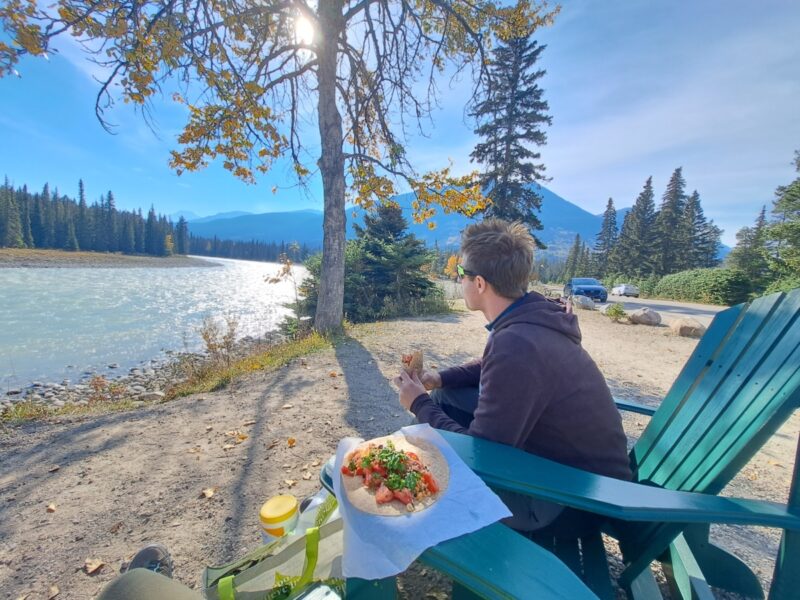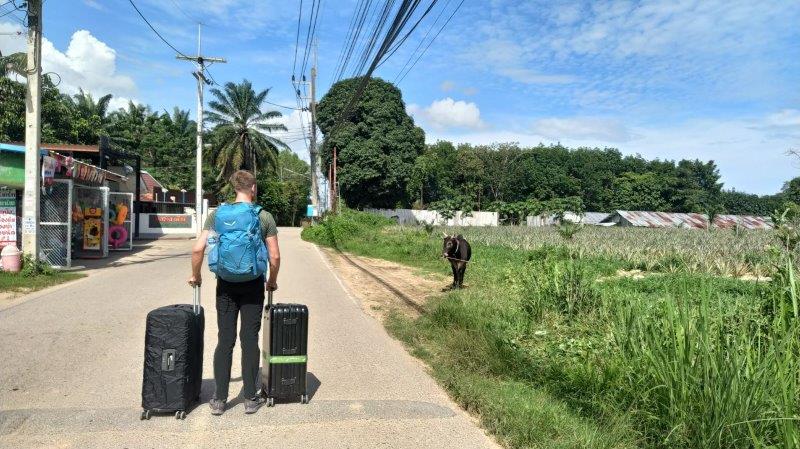In today’s fast-moving world, the idea of slowing down can seem like a luxury we don’t have time for. But when it comes to travel, there’s a growing trend that goes against the rush: slow travel. This way of traveling is changing how we explore new places. Instead of rushing from one city to the next and checking off sights to see, slow travel focuses on the quality of your experiences. It’s about truly being in a place, connecting with the local culture, making real friendships, and taking the time to enjoy every moment, big or small.
In this article, we’re going to explore what slow travel really means and show you why it could be the best and safest way to travel. We’ll look into where it came from, its main ideas, and how you can make your trips more about slow travel. I’ll also share my personal experiences with slow travel, where taking my time led to unforgettable moments and insights that only happened because I wasn’t in a hurry.
Whether you travel all the time or are just thinking about your next vacation, this guide is here to suggest a new way to travel. A way that values deep, meaningful experiences more than just seeing everything, and teaches us to enjoy the journey itself. So welcome to the slower side of traveling. You might find it’s exactly what you’ve been looking for.

Stereotypical Travel vs. Slow Travel
Typically, travel brings to mind a rush to see every notable site, capturing fleeting snapshots of landmarks. This conventional approach emphasizes ticking off numerous destinations quickly. In contrast, if you slow down when traveling, it invites a more measured pace, focusing on immersing oneself in the local culture, forging genuine connections, and deeply experiencing a place rather than merely accumulating visits.
Slow travel encourages lingering in neighborhoods, enjoying local cuisine outside of tourist spots, and integrating into daily life, turning travel into a collection of meaningful interactions rather than a series of visits. It’s about choosing depth of experience over breadth, like preferring a local cooking class over queueing at a tourist hotspot, allowing for a richer, more integrated experience.
What is the Slow Travel Trend?
Gaining traction amidst a rising tide of mindfulness and environmental consciousness, slow travel mirrors the ethos of the 1980s’ slow food movement. It champions a deeper connection with local customs, people, and the environment, promoting emotionally rich and environmentally sustainable travel.
This movement challenges the modern preoccupation with fast-paced travel, advocating for a journey that values authenticity, connection, and environmental stewardship. Slow travel suggests less flying and more local engagement, supporting small businesses and sustainable practices, embracing a travel philosophy that cherishes the journey as much as the destination.
How Can I Embrace Slow Travel?
Embracing slow travel means rethinking our rush to see and do everything when we travel. This movement focuses on immersing ourselves fully in the experiences of the places we visit, creating meaningful connections with local cultures, and living more like a local than a tourist. This approach not only enriches your travel experience but also benefits the local communities and the environment, by prioritizing sustainable practices and deeper cultural engagement.
As you plan for a slower pace of travel, consider how each destination can enrich your understanding of the world. Opt for places that naturally lend themselves to a slower rhythm and embrace practices that enhance mindfulness and environmental sustainability. This guide aims to inspire a shift from viewing travel as a checklist of destinations to a journey of genuine connection and discovery. Slow travel offers a unique opportunity to explore the world in a way that is both deeply personal and profoundly respectful of the cultures and environments we visit.
Benefits of Slow Travel
Slow travel brings a myriad of benefits that stretch beyond the immediate joy and relaxation we seek in our vacations. Imagine settling into a cozy café in a small town, sipping on coffee brewed from locally sourced beans, and having the time to observe the ebb and flow of daily life around you. This is the heart of slow travel—immersing yourself in a place to the extent that you start to live like a local, even if just for a short while. This deeper engagement allows for a more authentic and enriching experience, often leading to stories and memories that are far more personal and meaningful than those garnered from a hurried sightseeing tour.

But the benefits don’t end with personal fulfillment. Slow travel acts as a boon to local economies. When travelers choose to spend their money on local accommodations, eateries, and artisans, they’re directly supporting the community and often contributing to the preservation of local culture and traditions. Moreover, by favoring low-impact transportation options like biking, walking, or using public transit, and opting for eco-friendly lodging, slow travelers minimize their environmental footprint. This sustainable approach helps preserve the natural beauty and integrity of destinations, ensuring they remain vibrant for future generations to visit and enjoy.
7 Tips to Slow Down When Traveling
1. Choose Your Destination Wisely
Look for places that naturally lend themselves to a leisurely pace. Whether it’s a serene beach, a tranquil village nestled in the mountains, or a quiet rural setting, selecting the right location is the first step towards a slower, more immersive travel experience.
2. Embrace Local Living
Choose accommodations that reflect the local way of life, such as a family-run guesthouse, a cozy bed and breakfast, or a home rental in a residential area. Eat where the locals eat, not just in tourist spots, to discover authentic flavors and dishes. Shop at local markets, and if you have access to a kitchen, try your hand at cooking with local ingredients.
3. Limit Your Itinerary
Resist the urge to fill every minute of your day with activities. Instead, leave space for spontaneity. Give yourself the liberty to discover a secluded passageway or linger for an additional hour at a café or local restaurant, or simply relax and watch the world go by.
4. Travel Slowly
Whenever possible, choose to walk or bike to truly connect with your surroundings. Use public transport over flying or driving, which not only reduces your carbon footprint but also offers a unique window into the daily lives of locals.
An important aspect of preparing for such immersive journeys is understanding and overcoming travel insurance misconceptions. Often, travelers might skip insurance, thinking it’s unnecessary for slower-paced journeys, but the reality is, being well-informed and protected can make slow travel more serene and secure, allowing you to focus on the depth of your experiences rather than worrying about the ‘what-ifs.’
5. Seek Out Meaningful Experiences
Prioritize activities that offer a deep dive into the local culture. This could be a workshop, a cultural event, or a nature hike guided by someone from the area. Such experiences not only enrich your travel but also foster a greater appreciation for the place and its people.

Slow travel isn’t about ticking off every sight; it’s about savoring moments, whether that’s through a leisurely cycle around a lake, a month-long stay in a small village, or taking local cooking classes.
6. Practice Mindfulness
Take time each day to really absorb your surroundings. Notice the details—the colors, sounds, and smells. This practice not only enhances your travel experience but can also improve your overall well-being.
7. Support Sustainable Practices
Choose accommodations and tour companies that prioritize sustainability. This could mean staying at eco-lodges, participating in conservation projects, or even just making sure to leave no trace when exploring natural environments.
Embracing the Journey
Embarking on a journey of slow travel opens doors to a world where travel is not just about the destinations we check off our lists but about the depth of our experiences and the connections we forge along the way. This guide has walked you through the transformative philosophy of slow travel, from its roots in the slow food movement to its embrace of sustainability and meaningful cultural engagement. We’ve shared tips for integrating slow travel into your adventures, from selecting the right destinations to practicing mindfulness and supporting sustainable practices.
As you look forward to your future travels, consider adopting the principles of slow travel to enrich your experiences. By doing so, you’re not just a visitor passing through; you become a part of the community, leaving a positive impact on the places you visit and returning home with stories and memories that are as rich and varied as the cultures you’ve embraced. Slow travel is more than a way to see the world; it’s a way to experience life more fully, deeply, and intentionally. So take the step, slow down, and discover the boundless joys of traveling at the pace of life.
FAQ about Slow Travel
1. Is slow travel sustainable?
Yes, slow travel significantly reduces environmental impact and supports local economies by engaging deeply with one place, making it a responsible and sustainable travel option (Brogan Abroad).
2. How can I make my slow travel experiences more meaningful?
Enhance your slow travel experiences by seeking local recommendations and engaging in community-supporting activities like eating local foods and shopping at local markets.
3. What are some slow travel activities?
Activities like backpacking, housesitting, remote working, cycling, and engaging in homestays or guided tours with local insights are popular among slow travelers for deeper cultural immersion (Little Lost Travel).
4. How do I start slow traveling?
Start by living like a local, avoiding over-planning, embracing new challenges, and making meaningful connections with people and the environment you’re visiting (Remote Year).

No Comments